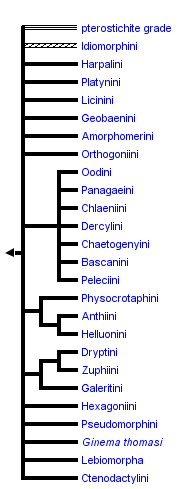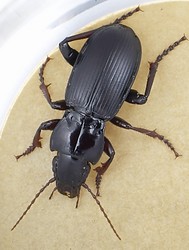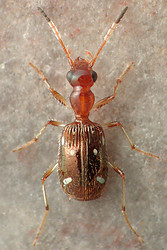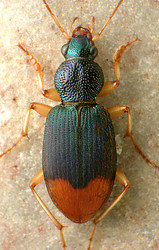Harpalinae
Kipling Will and David R. Maddison


This tree diagram shows the relationships between several groups of organisms.
The root of the current tree connects the organisms featured in this tree to their containing group and the rest of the Tree of Life. The basal branching point in the tree represents the ancestor of the other groups in the tree. This ancestor diversified over time into several descendent subgroups, which are represented as internal nodes and terminal taxa to the right.

You can click on the root to travel down the Tree of Life all the way to the root of all Life, and you can click on the names of descendent subgroups to travel up the Tree of Life all the way to individual species.
For more information on ToL tree formatting, please see Interpreting the Tree or Classification. To learn more about phylogenetic trees, please visit our Phylogenetic Biology pages.
close boxIntroduction
This large clade contains more than half of carabid species. It is supported as monophyletic by both morphological and molecular data (Maddison et al., 1999; Ober, 2002).Characteristics
The Harpalinae comprise those carabids with conjunct mesocoxae (as explained on the page for the Carabidae Conjunctae, and which also have the following features:- male parameres conchoid and asetose (in rare cases, e.g. Pseudamara arenaria, parameres have some apical setae)
- mandible lacking scrobal seta (various taxa may have numerous short fine setae in the scrobe and in rare cases, e.g. Metius robustus, there may be a single more substantial seta. However, this condition is recognizably different than the single robust fixed seta in the scrobe of non-harpalinae taxa)
- Configuration of abdomen:Tergum VIII partially or totally invaginated with anterolateral apophyses present. Pygidial gland opening near the posterior margin of tergum VIII.
- most species spray hydrocarbons and formic acid in defense secretions (Moore, 1979)
- male chromosome number in most species 2n=36+x
- high-grade wedge-pushing ability
References
Maddison, D.R., M.D. Baker, and K.A. Ober. 1999. Phylogeny of carabid beetles as inferred from 18S ribosomal DNA (Coleoptera: Carabidae). Systematic Entomology, 24:103-138.
Ober, K.A. 2002. Phylogenetic relationships of the carabid subfamily Harpalinae (Coleoptera) based on molecular sequence data. Molecular Phylogenetics and Evolution, 24: 228-248.
Title Illustrations

| Scientific Name | Pterostichus morionides |
|---|---|
| Identified By | K.Will |
| Life Cycle Stage | Adult |
| Image Use |
 This media file is licensed under the Creative Commons Attribution License - Version 3.0. This media file is licensed under the Creative Commons Attribution License - Version 3.0.
|
| Copyright |
© Kipling Will

|
| Scientific Name | Calybe sallei |
|---|---|
| Location | USA: Texas: Fredonia |
| Specimen Condition | Dead Specimen |
| Sex | female |
| Image Use |
 This media file is licensed under the Creative Commons Attribution License - Version 3.0. This media file is licensed under the Creative Commons Attribution License - Version 3.0.
|
| Copyright |
© 2005 David R. Maddison

|
| Scientific Name | Bradycellus |
|---|---|
| Location | USA: New Mexico: Grant Co., Gila River, Billings Vista |
| Specimen Condition | Dead Specimen |
| Image Use |
 This media file is licensed under the Creative Commons Attribution License - Version 3.0. This media file is licensed under the Creative Commons Attribution License - Version 3.0.
|
| Copyright |
© 2005 David R. Maddison

|
| Scientific Name | Chlaenius ruficauda |
|---|---|
| Location | USA: New Mexico: Grant Co., Gila River, Billings Vista |
| Specimen Condition | Dead Specimen |
| Identified By | David Maddison |
| Sex | Male |
| Image Use |
 This media file is licensed under the Creative Commons Attribution License - Version 3.0. This media file is licensed under the Creative Commons Attribution License - Version 3.0.
|
| Copyright |
© 2002 David R. Maddison

|
About This Page
Kipling Will

University of California, Berkeley, California, USA
David R. Maddison

Oregon State University
Correspondence regarding this page should be directed to Kipling Will at and David R. Maddison at
Page copyright © 2012 Kipling Will and David R. Maddison
 Page: Tree of Life
Harpalinae.
Authored by
Kipling Will and David R. Maddison.
The TEXT of this page is licensed under the
Creative Commons Attribution License - Version 3.0. Note that images and other media
featured on this page are each governed by their own license, and they may or may not be available
for reuse. Click on an image or a media link to access the media data window, which provides the
relevant licensing information. For the general terms and conditions of ToL material reuse and
redistribution, please see the Tree of Life Copyright
Policies.
Page: Tree of Life
Harpalinae.
Authored by
Kipling Will and David R. Maddison.
The TEXT of this page is licensed under the
Creative Commons Attribution License - Version 3.0. Note that images and other media
featured on this page are each governed by their own license, and they may or may not be available
for reuse. Click on an image or a media link to access the media data window, which provides the
relevant licensing information. For the general terms and conditions of ToL material reuse and
redistribution, please see the Tree of Life Copyright
Policies.
- Content changed 07 July 2006
Citing this page:
Will, Kipling and David R. Maddison. 2006. Harpalinae. Version 07 July 2006 (under construction). http://tolweb.org/Harpalinae/100/2006.07.07 in The Tree of Life Web Project, http://tolweb.org/













 Go to quick links
Go to quick search
Go to navigation for this section of the ToL site
Go to detailed links for the ToL site
Go to quick links
Go to quick search
Go to navigation for this section of the ToL site
Go to detailed links for the ToL site